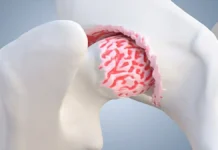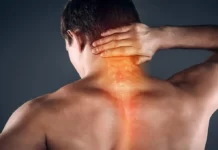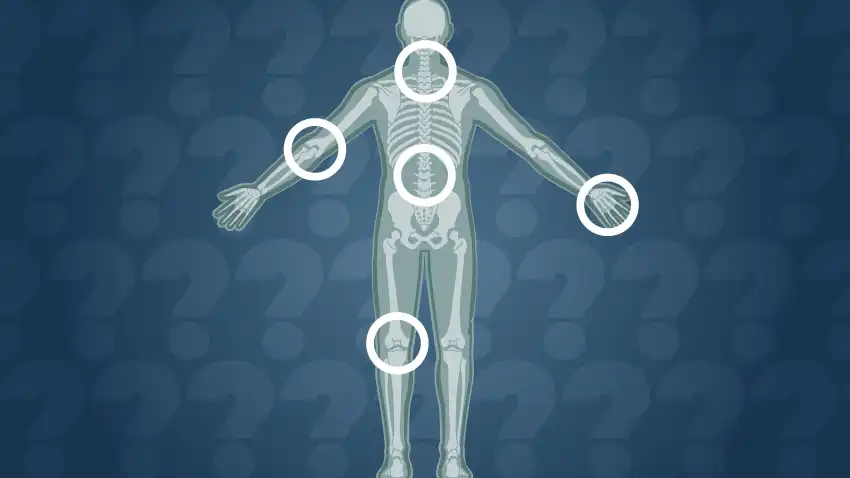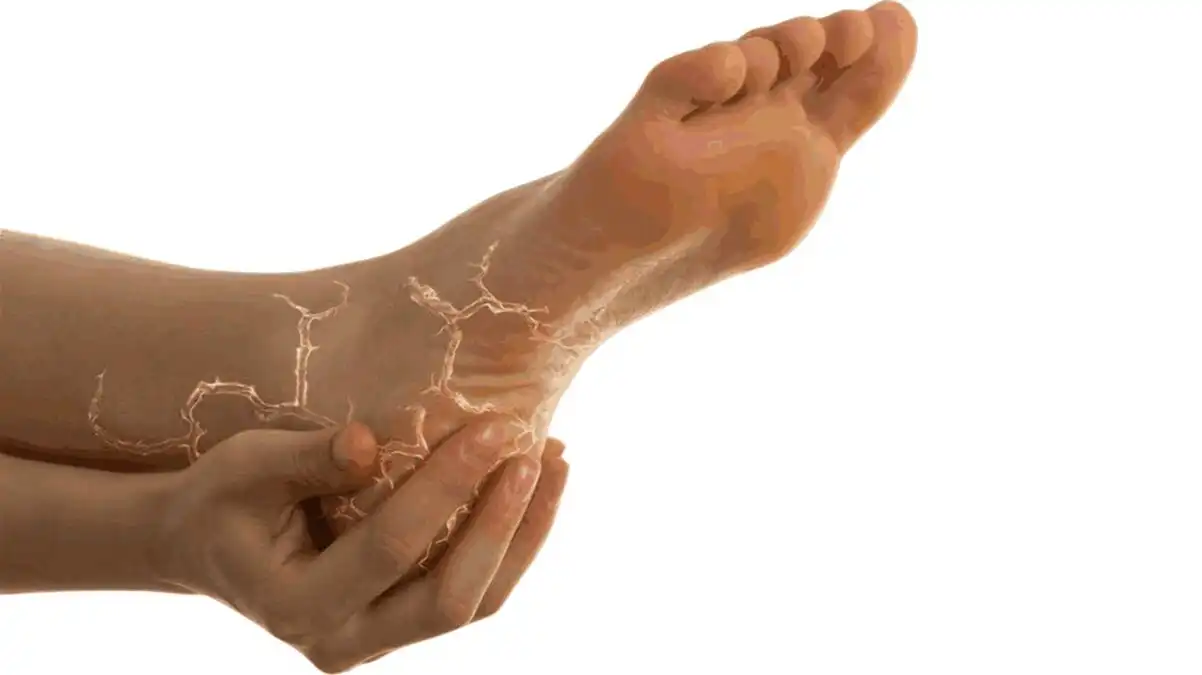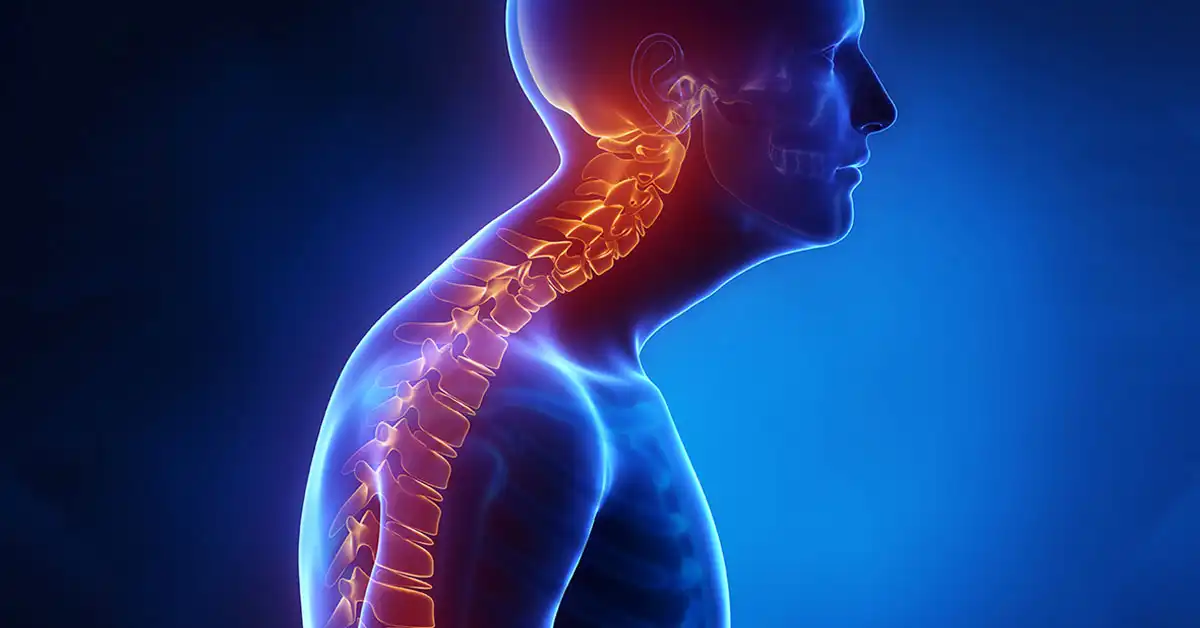Osteoarthritis, the most common form of arthritis, is a progressive disease affecting the entire joint.
Introduction
Osteoarthritis, commonly known as osteoarthritis, is a chronic degenerative joint disease that primarily targets the body’s mobile joints, including the knees, hips, hands and spine. This condition is characterized by the gradual breakdown of cartilage, an essential structure that covers the bone ends within joints. Cartilage plays a fundamental role in facilitating joint movement by ensuring a smooth surface and absorbing shock.
With osteoarthritis, the cartilage undergoes a process of wear and tear over time. It gradually thins, and in some cases, may even disappear, exposing the underlying bones. This alteration of the cartilage leads to an increase in friction between the bones during movements, inducing joint pain, a feeling of stiffness and a reduction in mobility. It is important to note that osteoarthritis is not just about cartilage breakdown; it can also impact other joint components such as the synovial membrane and ligaments.
Although osteoarthritis is often associated with the natural aging process, it can also result from a variety of factors. Previous joint trauma, genetic predispositions, obesity and congenital joint abnormalities are all factors that can contribute to the development of osteoarthritis. These elements can act individually or in combination, thus triggering the degenerative process in the joints.
Osteoarthritis symptoms can vary in intensity from person to person, and they often progress gradually over time. Common signs include joint pain, which may be acute or chronic, joint stiffness, especially after periods of inactivity, and decreased mobility in the affected joints. These symptoms can have a significant impact on quality of life, limiting the ability to perform daily activities and impairing the functionality of affected joints.
The aging population and modern lifestyle, characterized by a sedentary lifestyle and increasing obesity, contribute to the increasing prevalence of osteoarthritis. Due to its chronic nature and its impact on quality of life, the management of osteoarthritis requires a multidisciplinary approach. Treatment options include conservative measures such as physical therapy, weight management, analgesic and anti-inflammatory medications, as well as more invasive interventions like joint surgery, when necessary.
In conclusion, osteoarthritis remains a debilitating joint condition, characterized by the progressive breakdown of cartilage and affecting various joints throughout the body. Understanding the risk factors and symptoms associated with this condition is essential for early diagnosis and effective management. As medical research advances, new treatment strategies emerge, providing continued hope for improving the quality of life of those affected by osteoarthritis.
Causes of Osteoarthritis
- Aging: Natural aging is one of the main causes of osteoarthritis. With age, cartilage tends to wear out and lose its elasticity.
- Genetic factors: There is a genetic component in the development of osteoarthritis. If family members have suffered from osteoarthritis, this may increase a person’s risk.
- Joint overload: Excessive use or repeated loads on a joint can accelerate cartilage wear. This can be due to professional, sporting activities or excess weight.
- Joint trauma: Joint injuries, such as severe sprains or fractures involving a joint, can damage cartilage and contribute to the development of osteoarthritis later in life.
- Joint abnormalities: Birth defects or structural joint abnormalities can increase the risk of osteoarthritis.
- Obesity: Excess weight puts extra pressure on joints, especially those that support body weight, such as the knees and hips.
- Joint inflammation: Inflammatory diseases such as rheumatoid arthritis can damage cartilage and increase the risk of osteoarthritis.
- Insufficient physical activity: Physical inactivity can weaken the muscles around the joints, which can contribute to the development of osteoarthritis.
Symptoms of Osteoarthritis
- Joint Pain: Pain is one of the most common symptoms of osteoarthritis. It is usually experienced during or after use of the joint and may worsen over time.
- Joint Stiffness: Joints affected by osteoarthritis can become stiff, especially in the morning or after a period of inactivity. Stiffness tends to improve with movement.
- Loss of Flexibility: Due to cartilage deterioration, the flexibility and mobility of the joint may decrease. Movements may become more limited.
- Crackles or Crackles: Some patients may feel or hear crackles, crackles, or grinding sounds when using an affected joint. This is due to friction between bones.
- Swelling: Mild inflammation may develop around the affected joint, causing slight swelling.
- Joint Deformity: In some advanced cases, osteoarthritis can cause visible joint deformity, changing the normal shape of the joint.
- Limitation of Daily Activities: Due to pain and stiffness, daily activities such as walking, climbing stairs, opening jars, or writing may become more difficult.
It is important to note that osteoarthritis symptoms can vary in intensity from person to person, and not all symptoms are present in every individual.
Steps in the Evolution of Joint Destruction in Osteoarthritis
- Cartilage Degradation: Gradual thinning and wear of cartilage due to mechanical stress, aging, or injury.
- Chondrocyte Dysfunction: The cells responsible for cartilage repair become impaired, leading to reduced regenerative capacity.
- Subchondral Bone Changes: The bone under the cartilage thickens and hardens (sclerosis), contributing to joint stiffness.
- Synovial Inflammation: The joint lining (synovium) becomes mildly inflamed, releasing enzymes that accelerate cartilage breakdown.
- Osteophyte Formation: Bone spurs develop at joint margins in response to damage, limiting mobility and causing pain.
- Joint Space Narrowing: The loss of cartilage reduces the space between bones, increasing friction and wear.
- Joint Deformity: Chronic damage leads to misalignment and structural changes in the joint.
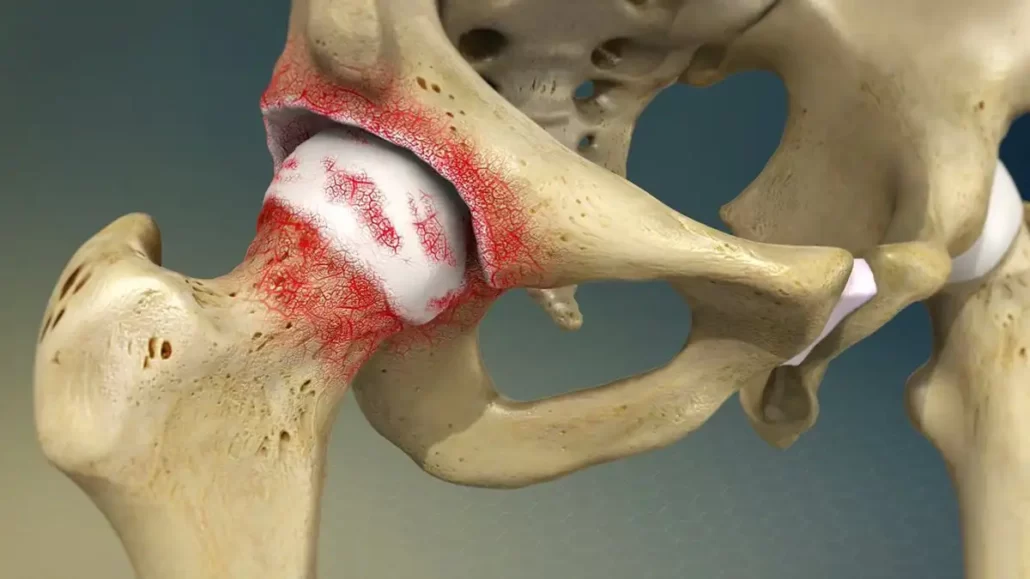
Evolution of Joint Destruction in Osteoarthritis
Osteoarthritis (OA) is a progressive degenerative disease that primarily affects the cartilage in joints, but its impact extends beyond the cartilage to involve the entire joint structure. Understanding the stages of joint destruction in OA sheds light on how this condition evolves and helps in devising effective prevention and treatment strategies.
1. Cartilage Degradation: The Starting Point
The first stage of osteoarthritis begins with the gradual breakdown of cartilage, a smooth and resilient tissue that cushions the ends of bones. Cartilage absorbs shock and minimizes friction during movement. Over time, mechanical stress from daily activities, injuries, or excess weight wears down this protective layer. Aging also plays a significant role, as cartilage loses elasticity and becomes more prone to damage. Early cartilage wear may not cause symptoms initially, but microscopic cracks and fraying gradually appear, initiating the degenerative process.
2. Chondrocyte Dysfunction: Reduced Repair Mechanisms
Chondrocytes, the cells responsible for maintaining and repairing cartilage, become less effective as osteoarthritis progresses. Normally, these cells produce collagen and proteoglycans, the building blocks of cartilage. In OA, they enter a state of dysfunction, producing more enzymes that degrade cartilage than those needed for repair. This imbalance accelerates cartilage loss, leaving the underlying bone exposed.
3. Subchondral Bone Changes: Hardening and Sclerosis
As cartilage thins, the subchondral bone—located just beneath the cartilage—becomes increasingly exposed to mechanical stress. In response, the bone undergoes remodeling, thickening, and hardening, a process known as sclerosis. While this may seem like a protective mechanism, it disrupts the joint’s ability to absorb shock and causes additional stress on surrounding structures. Subchondral bone changes also contribute to joint pain and stiffness.
4. Synovial Inflammation: An Amplifying Factor
Although osteoarthritis is not primarily an inflammatory disease, inflammation in the joint lining (synovium) often occurs as the condition progresses. The synovium produces synovial fluid, which lubricates and nourishes the joint. In OA, the synovium becomes mildly inflamed, releasing inflammatory cytokines and enzymes that further degrade cartilage. This low-grade inflammation contributes to pain and swelling, particularly during flare-ups or after periods of overuse.
5. Osteophyte Formation: Bone Spur Development
In an attempt to stabilize the damaged joint, the body forms osteophytes, or bone spurs, at the edges of the joint. While these bony outgrowths are intended to provide additional support, they often restrict movement and irritate surrounding tissues. Osteophytes can also contribute to joint stiffness and deformity, worsening the functional limitations experienced by individuals with OA.
6. Joint Space Narrowing: Increased Bone Friction
As cartilage continues to wear away, the joint space—the gap between the bones—begins to narrow. This reduction in joint space results in increased bone-on-bone contact during movement, leading to grinding sensations, crackling noises (crepitus), and further pain. The loss of cushioning from cartilage exacerbates the mechanical stress on the joint, accelerating the degenerative process.
7. Joint Deformity: The Final Stage
In advanced osteoarthritis, the cumulative damage to cartilage, bone, and surrounding structures leads to joint deformity. Misalignment of the bones and structural changes, such as bowing or angulation, become evident. These deformities significantly impair joint function, causing severe pain, reduced mobility, and a substantial decline in quality of life. At this stage, conservative treatments may no longer be effective, and joint replacement surgery is often considered.

On the right, the osteoarthritic joint reveals progressive deterioration. The cartilage has begun to break down, exposing underlying bone and leading to friction during movement. Bone spurs, or osteophytes, have formed as a result of the body’s attempt to repair the damage. The meniscus, a critical shock-absorbing structure, is eroding, further reducing the joint’s ability to function properly. These changes cause pain, stiffness, and reduced mobility.
Osteoarthritis is a degenerative joint condition commonly seen in weight-bearing joints like the knees. Contributing factors include age, injury, obesity, and genetic predisposition. Early intervention and care can help slow the progression of damage and preserve joint function. Treatments such as physical therapy, osteopathy, and lifestyle adjustments aim to alleviate pain, improve mobility, and enhance overall quality of life. Understanding these differences underscores the importance of joint health and proactive care.
The Role of Articular Cartilage in the Onset of Joint Degeneration”
Articular cartilage plays a critical role in maintaining healthy joint function and mobility. Its degeneration marks the beginning of osteoarthritis and other joint disorders. As the primary shock absorber and friction-reducing structure in the joints, articular cartilage ensures smooth and pain-free movement. However, when this vital tissue starts to deteriorate, it triggers a cascade of changes that ultimately affect the entire joint structure.
One of the earliest indicators of joint degeneration is the degradation of the articular cartilage surface. Over time, the once-smooth and shiny surface begins to crack and split. These changes occur due to a reduction in the cartilage’s chondroitin sulfate content, a key molecule responsible for maintaining its elasticity and water-retaining properties. Chondroitin sulfate ensures that cartilage can handle the stress of daily activities, such as walking, running, or lifting. As its levels decrease, the cartilage loses its resilience, becoming more susceptible to wear and tear.
The deeper layers of cartilage also undergo significant changes during the degeneration process. In some areas, the cartilage swells as it tries to compensate for the damage, while in others, it becomes friable and brittle, further reducing its ability to protect the joint. These structural changes are not uniform; instead, they vary across different regions of the joint, reflecting the varying stresses and loads placed on it.
The initial damage to articular cartilage often goes unnoticed, as it lacks nerve endings and does not cause pain directly. However, the changes in its structure compromise its ability to distribute load evenly across the joint. This leads to increased stress on the underlying bone and surrounding tissues, setting the stage for further degeneration.
As the cartilage continues to deteriorate, the bones beneath it become exposed to increased mechanical stress. This stress can lead to subchondral bone sclerosis, where the bone hardens and thickens in response to the increased load. Additionally, small cracks may form in the cartilage and extend into the bone, creating pathways for inflammatory mediators to enter the joint and exacerbate the degenerative process.
The loss of cartilage also affects the synovial fluid, which lubricates and nourishes the joint. Without the protective barrier of healthy cartilage, the synovial fluid becomes less effective, further reducing the joint’s ability to move smoothly. These changes contribute to the characteristic symptoms of osteoarthritis, including pain, stiffness, and reduced range of motion.
Understanding the role of articular cartilage in joint degeneration highlights the importance of early detection and intervention. Protecting cartilage health through lifestyle modifications, such as maintaining a healthy weight and engaging in low-impact exercises, can help slow the progression of degeneration. Additionally, therapeutic approaches like osteopathy, physical therapy, and nutritional supplementation aim to support cartilage function and prevent further damage.
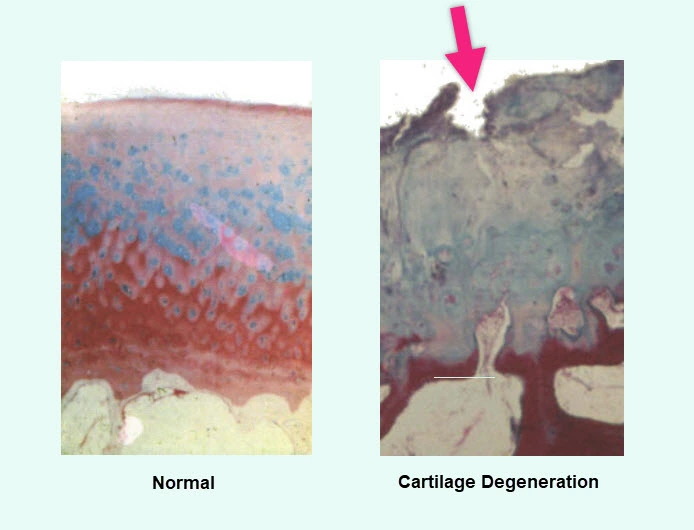
On the left, the normal cartilage demonstrates a smooth, uniform surface with densely packed chondrocytes (cartilage cells) and a well-organized extracellular matrix. The vibrant red and blue staining represents healthy proteoglycan content, which helps cartilage retain water and maintain its elasticity. This structure allows the cartilage to provide a smooth, frictionless surface for joint movement while cushioning the underlying bone.
On the right, the cartilage degeneration is evident. The surface has become irregular, with cracks and fissures (highlighted by the arrow), signifying the breakdown of the extracellular matrix. The loss of proteoglycans is indicated by diminished staining, and the cartilage appears fragmented and friable. These structural changes impair the cartilage’s ability to absorb shock and reduce friction, leading to increased stress on the underlying bone and surrounding tissues.
This comparison underscores the importance of early detection and prevention of cartilage degeneration to maintain joint health and mobility. Addressing cartilage damage through lifestyle changes, therapeutic interventions, and medical treatments can help slow the progression of joint diseases like osteoarthritis.
Common and Less Common Locations of Osteoarthritis
Osteoarthritis (OA) is a degenerative joint disease that can affect various joints throughout the body. Its prevalence in specific locations is often influenced by factors such as joint load, usage patterns, and prior injuries. Below is a detailed exploration of the most common and less common locations for osteoarthritis, the physical presentations, and the specific conditions associated with each affected joint.
1. Knees (Gonarthrosis): The Most Common Location
The knees are the most frequently affected joints in osteoarthritis, primarily due to their role as weight-bearing structures. The constant stress from walking, running, and other activities, combined with aging, makes the knee joints particularly susceptible to wear and tear. Gonarthrosis, the term for knee osteoarthritis, leads to symptoms such as pain, swelling, and stiffness. Over time, the cartilage wears away, resulting in bone-on-bone contact that causes severe discomfort and deformity. Physical examination often reveals joint swelling, reduced range of motion, and crepitus (a grinding or crackling sound during movement).
Causes:
- Obesity, which increases mechanical load on the knees
- Previous injuries, such as ligament tears or meniscus damage
- Repetitive strain from activities like running or heavy lifting
2. Hips (Coxarthrosis): Second Most Common
The hips are another common site for osteoarthritis, referred to as coxarthrosis. These joints bear significant weight and facilitate a wide range of motion, making them prone to degeneration. Coxarthrosis causes pain in the hip joint, which may radiate to the groin, thigh, or buttocks. Stiffness, especially after periods of inactivity, is a hallmark symptom. Advanced cases often result in difficulty walking, reduced hip rotation, and limb shortening due to joint deformity.
Causes:
- Aging and genetic predisposition
- Developmental conditions like hip dysplasia
- Previous fractures or dislocations
3. Hands (Herberden’s and Bouchard’s Nodes)
Osteoarthritis in the hands commonly affects the small joints, particularly the distal interphalangeal (DIP) joints and proximal interphalangeal (PIP) joints. This condition often presents as Herberden’s nodes (bony enlargements in DIP joints) or Bouchard’s nodes (bony enlargements in PIP joints). The base of the thumb (the first carpometacarpal joint) is also frequently involved, causing pain and reduced grip strength. Patients may experience stiffness, swelling, and difficulty with fine motor tasks.
Causes:
- Genetic predisposition
- Repeated use of the hands in manual tasks
- Post-menopausal hormonal changes in women

4. Spine (Spondylosis): A Frequent Cause of Back Pain
Osteoarthritis of the spine, known as spondylosis, affects the facet joints in the cervical, thoracic, or lumbar regions. It can lead to localized pain, stiffness, and reduced flexibility in the spine. In severe cases, bony overgrowths (osteophytes) may compress nearby nerves, causing radiating pain, numbness, or weakness in the arms or legs.
Causes:
- Age-related degeneration
- Poor posture and sedentary lifestyle
- Heavy lifting or repetitive spinal strain
5. Shoulders and Elbows (Less Common Locations)
Osteoarthritis in the shoulders and elbows is less common compared to weight-bearing joints. When it does occur, it is often secondary to trauma, repetitive use, or underlying inflammatory conditions. In the shoulder, OA primarily affects the glenohumeral joint, causing pain, stiffness, and difficulty with overhead movements. In the elbow, OA leads to pain, locking, and limited extension.
Causes:
- Previous injuries, such as rotator cuff tears or fractures
- Overuse in sports or occupations requiring repetitive arm movements
6. Ankles and Feet (Rare Locations)
The ankle and foot joints are rarely affected by primary osteoarthritis but may develop secondary OA following trauma or deformities like flat feet. Pain, swelling, and difficulty walking are the primary symptoms. The first metatarsophalangeal joint (big toe joint) is a common site, leading to a condition known as hallux rigidus, which causes stiffness and pain during walking7. Temporomandibular Joint (TMJ): Rare but Impactful
Osteoarthritis in the temporomandibular joint (TMJ), though uncommon, can significantly impact quality of life due to its role in jaw movement. This condition causes pain in the jaw, clicking or popping sounds, stiffness, and difficulty opening or closing the mouth. TMJ osteoarthritis can lead to issues such as uneven wear on the teeth and referred pain in the ears or head.
Causes:
- Chronic teeth grinding (bruxism)
- Jaw misalignment or previous trauma
- Rheumatoid arthritis or other inflammatory conditions
Physical Presentation:
Patients may report facial pain, jaw locking, or reduced ability to chew. Palpation of the joint often reveals tenderness and limited movement.
8. Sternoclavicular and Acromioclavicular Joints (Rare)
Osteoarthritis in the sternoclavicular (SC) and acromioclavicular (AC) joints is rare but can occur due to repetitive upper body strain or aging. These joints are crucial for shoulder and chest movements. OA in these areas causes localized pain, swelling, and difficulty lifting objects or performing overhead movements.
Causes:
- Aging and degeneration
- Trauma or heavy lifting
- Sports injuries involving repetitive strain
Physical Presentation:
Pain is usually felt during shoulder movements or when pressing on the affected joint. Swelling and reduced range of motion are common.
9. Hips and Knees: The Overlapping Burden
While hips and knees are individually discussed as the most common sites, it is important to note that many patients experience osteoarthritis in both locations simultaneously. The combined burden on weight-bearing joints exacerbates mobility challenges, often necessitating assistive devices or joint replacement surgeries.
Osteoarthritis Prevention
Prevention of osteoarthritis is based on several measures related to lifestyle and daily habits. Here are some tips to reduce the risk of developing osteoarthritis:
- Maintain a healthy weight: Excess weight puts extra pressure on joints, especially those in the knees, hips and spine. Maintaining a healthy body weight can reduce stress on joints and help prevent osteoarthritis.
- Eat a balanced diet: A diet rich in nutrients, particularly calcium and vitamin D, can contribute to bone and joint health. Foods rich in omega-3, such as oily fish, may also have beneficial anti-inflammatory effects.
- Engage in regular physical activity: Exercise strengthens the muscles that surround the joints, protecting them from excessive stress. Low-impact activities, such as swimming, cycling, and walking, are particularly beneficial for maintaining joint flexibility without overtaxing them.
- Avoiding joint trauma: Joint injuries, whether from sports, accidents or other activities, can increase the risk of developing osteoarthritis. It is important to take precautions, such as using appropriate protective equipment, to avoid joint trauma.
- Adopt good posture: Correct posture when walking, sitting or other activities can help reduce pressure on the joints. Ergonomists can help design work and living environments that promote correct posture.
- Avoid smoking: Studies have shown that smoking can increase the risk of developing osteoarthritis. By stopping smoking, you can reduce this predisposition.
- Manage stress: Chronic stress can contribute to inflammation in the body, which can worsen osteoarthritis symptoms. Practicing stress management techniques, such as meditation and yoga, can be beneficial.
- See a healthcare professional regularly: Regular medical checkups can help identify any early signs of osteoarthritis. A healthcare professional can provide personalized advice based on each individual’s overall health.
By adopting these preventative measures, individuals can help reduce their risk of developing osteoarthritis and maintain joint health throughout their lives. It is important to consult a healthcare professional for advice specific to your individual situation.
Comparison between osteoarthritis and arthritis
Understanding the Differences Between Arthrosis and Arthritis
Arthrosis, also known as osteoarthritis, and arthritis are two distinct conditions that affect the joints, each with unique causes, symptoms, and mechanisms. Understanding their differences is crucial for proper diagnosis and management.
Arthrosis (Osteoarthritis):
Arthrosis is a degenerative joint disease primarily caused by the wear and tear of cartilage, which serves as a protective cushion between bones. Over time, the cartilage gradually wears away, often due to aging, repetitive joint use, or genetic predisposition. As the cartilage deteriorates, the bones come into closer contact, leading to increased friction during movement. This results in joint pain, stiffness, and, in some cases, a sensation of crackling or grinding noises (crepitus) during movement. Arthrosis-related stiffness tends to be more pronounced after periods of inactivity, such as sitting or lying down, but often improves with gentle movement. Pain in arthrosis is predominantly mechanical, arising from the stress placed on the exposed bones rather than inflammation.
Arthritis:
Arthritis, on the other hand, is characterized by inflammation of the joints. Unlike arthrosis, arthritis can have various causes, including autoimmune diseases (e.g., rheumatoid arthritis), infections, or metabolic conditions like gout. The primary mechanism in arthritis is inflammation, which leads to joint pain, swelling, and stiffness. The pain is often persistent and associated with warmth and tenderness in the affected joints. Stiffness in arthritis is typically more severe in the morning or after prolonged periods of inactivity, sometimes referred to as “morning stiffness.” Swelling results from fluid accumulation within the joint capsule, further contributing to discomfort and limited mobility.
Key Differences:
While both conditions cause joint pain and stiffness, their origins differ significantly. Arthrosis is primarily mechanical, resulting from cartilage degradation, while arthritis is inflammatory, driven by the body’s immune response or other pathological processes. Arthrosis-related stiffness tends to improve with movement, whereas arthritis-associated stiffness is often worse in the morning. Additionally, swelling is a hallmark of arthritis but not typically seen in arthrosis.
Psychological Impacts of Osteoarthritis
Osteoarthritis, due to chronic pain, loss of mobility and necessary life adjustments, can have significant impacts on the mental health and psychological well-being of those affected. Here are some psychological aspects linked to osteoarthritis:
Chronic Pain
- Depression and anxiety: Persistent pain can lead to feelings of hopelessness, sadness and anxiety. Constantly battling pain can contribute to emotional exhaustion.
- Social isolation: Chronic pain can make it difficult to participate in social activities, leading to isolation. This can lead to feelings of loneliness and distress.
Loss of Mobility
- Loss of independence: Reduced mobility can lead to a loss of independence, affecting self-esteem and self-confidence. People may feel frustrated by their increased dependence on others.
- Mourning the old life: The gradual loss of mobility can lead to mourning the previous life, with necessary adjustments in daily activities and personal projects.
Life Adjustments
- Financial Stress: Life adjustments, such as costs related to medical treatments, assistive devices and possible home adaptations, can lead to financial stress, causing worry and anxiety.
- Family role adjustment: Family members may also be affected by the adjustments needed to support the person with osteoarthritis. Family roles may be changed, leading to emotional and relational adjustments.
Pain and Stress Cycles
- Pain-stress cycle: Pain can lead to stress, which in turn can make the pain worse. This cycle can contribute to a negative spiral affecting mental health.
- Managing Emotions: Learning to manage emotions related to pain and the impact on daily life is essential to maintaining mental health.
Psychological Coping Strategies
- Psychological support: People with osteoarthritis may benefit from support from a mental health professional to develop coping strategies and overcome psychological challenges.
- Education and information: Understanding the illness, available treatments and coping strategies can help build psychological resilience.
Diagnosis of osteoarthritis
- History: Healthcare professionals will collect detailed information about symptoms, duration of onset, and any potential precipitating factors. Family medical history and previous joint injuries are also taken into account.
- Physical examination: A thorough physical examination is performed to assess range of motion, joint stability, and the presence of signs such as inflammation, deformities, or characteristic joint sounds.
- Radiological examinations: To confirm the diagnosis of osteoarthritis and assess the extent of joint damage, different imaging examinations can be used, such as:
- Radiographs (X-rays): These reveal specific features of osteoarthritis, such as loss of joint space and osteophyte formation.
- MRI (Magnetic Resonance Imaging): More sensitive for detecting changes in the soft tissues around joints.
- Bone scan: It evaluates blood perfusion and metabolic activity of bones, identifying areas of inflammation or degeneration.
- Synovial fluid analysis: A joint aspiration may be performed to collect and analyze the synovial fluid, helping to rule out other potential causes of the inflammation.
- Evaluation of biological markers: Certain blood tests may be done to rule out other possible causes of joint symptoms.
Care for Osteoarthritis: A Comprehensive Approach
Osteoarthritis (OA) is a degenerative joint condition that affects millions worldwide, leading to pain, stiffness, and reduced mobility. While it cannot be reversed, proper care and management strategies can significantly slow its progression, alleviate symptoms, and enhance the quality of life. The care for osteoarthritis involves a multidisciplinary approach that addresses both the physical and emotional impact of the condition.
1. Lifestyle Modifications
Adopting healthy lifestyle habits is crucial for managing osteoarthritis and preventing further joint damage. Some key lifestyle changes include:
- Weight Management: Excess weight places additional stress on weight-bearing joints like the knees and hips. Losing even a small amount of weight can reduce joint load and alleviate symptoms.
- Exercise: Regular, low-impact physical activity helps improve joint function and strengthen surrounding muscles. Activities such as swimming, walking, and yoga promote flexibility, reduce stiffness, and maintain range of motion. Strengthening exercises, guided by a healthcare professional, can stabilize joints and reduce pain.
- Diet: A balanced diet rich in anti-inflammatory foods, such as fruits, vegetables, fatty fish, and nuts, can help manage inflammation. Adequate calcium and vitamin D intake supports bone health.
2. Pain Management
Pain is one of the primary concerns in osteoarthritis, and managing it effectively is essential for improving daily function. Options for pain relief include:
- Medications: Over-the-counter nonsteroidal anti-inflammatory drugs (NSAIDs) like ibuprofen or acetaminophen can provide short-term relief. In more severe cases, prescription medications may be recommended.
- Topical Treatments: Creams and gels containing capsaicin or menthol can be applied directly to the affected joints for localized pain relief.
- Injections: Corticosteroid or hyaluronic acid injections into the joint can provide temporary pain relief and reduce inflammation. These are typically used for moderate to severe cases.
3. Osteopathy
Osteopathic care focuses on improving joint mobility, reducing stiffness, and alleviating pain through manual techniques. Osteopaths may use hands-on manipulation to address imbalances in the body that contribute to joint stress. This approach not only targets the affected joint but also promotes overall musculoskeletal health, helping to reduce pain and improve function. Osteopathy can be an effective complementary therapy to manage osteoarthritis symptoms and support joint health.
4. Assistive Devices
For individuals with advanced osteoarthritis or significant mobility challenges, assistive devices can provide support and reduce joint strain. Common devices include:
- Braces and Supports: These help stabilize affected joints, especially the knees, and reduce pain during activity.
- Canes and Walkers: Used to offload pressure from weight-bearing joints and improve balance.
- Orthopedic Footwear: Customized shoes or insoles can correct alignment and reduce stress on joints in the feet and knees.
5. Alternative Therapies
In addition to conventional treatments, many people find relief through complementary approaches.
- Acupuncture: Involves inserting thin needles into specific points of the body to reduce pain and inflammation.
- Massage Therapy: Helps alleviate muscle tension around affected joints, improving circulation and reducing discomfort.
- Supplements: Glucosamine and chondroitin supplements are commonly used, though evidence of their effectiveness is mixed. Always consult a healthcare professional before starting supplements.
6. Emotional and Psychological Support
Living with osteoarthritis can take an emotional toll, leading to frustration, anxiety, or depression. Addressing mental health is an integral part of care:
- Support Groups: Sharing experiences with others who have osteoarthritis can provide emotional support and practical advice.
- Cognitive Behavioral Therapy (CBT): A therapy that helps individuals manage chronic pain by changing negative thought patterns and behaviors.
- Mind-Body Practices: Techniques like meditation, deep breathing, and mindfulness can help reduce stress and improve pain tolerance.
7. Surgical Options
In severe cases where conservative treatments fail, surgical intervention may be necessary. Common surgical procedures include:
- Arthroscopy: A minimally invasive procedure to clean damaged cartilage or remove loose fragments.
- Osteotomy: Reshaping or repositioning bones to reduce joint stress.
- Joint Replacement (Arthroplasty): For advanced osteoarthritis, replacing the damaged joint with a prosthetic can restore mobility and relieve pain, particularly in the knees or hips.
8. Preventing Further Damage
Preventative measures can help slow the progression of osteoarthritis and protect joint health. These include avoiding high-impact activities, using proper body mechanics during daily tasks, and staying consistent with prescribed treatments.
Osteopathic Care for Osteoarthritis: Managing Symptoms and Slowing Progression
Osteopathy offers a holistic and non-invasive approach to managing osteoarthritis (OA). By focusing on improving joint mobility, strengthening surrounding muscles, and maintaining optimal joint function, osteopathic care can effectively relieve symptoms and slow the degenerative process. This approach complements other treatments and empowers patients to live more active, pain-free lives. Here’s an in-depth look at osteopathic care for osteoarthritis, including when to start, precautions to consider, and the techniques used.
When to Start Osteopathic Care for Osteoarthritis
Early intervention is key when managing osteoarthritis. Osteopathic care can begin as soon as symptoms like joint pain, stiffness, or reduced range of motion arise. Even in the absence of symptoms, individuals at higher risk of OA, such as those with a family history, obesity, or a history of joint injuries, can benefit from preventive osteopathic care.
Starting care early helps slow cartilage degeneration, improve muscle strength, and maintain joint function. It can also reduce the risk of secondary complications such as joint instability, muscle weakness, or chronic pain syndromes. However, osteopathic care remains effective even in later stages of OA by alleviating pain, enhancing mobility, and improving overall quality of life.
Precautions in Osteopathic Care
Osteopathy is generally safe and well-tolerated, but there are important precautions to consider:
- Individualized Assessment: Osteopathic treatments should be tailored to each patient’s condition, considering the stage of OA, joint involvement, and overall health. Osteopaths will assess the patient’s range of motion, muscle imbalances, and areas of pain before determining the appropriate techniques.
- Avoiding Over-Manipulation: In advanced OA, excessive manipulation of affected joints can cause discomfort or worsen symptoms. Techniques should be gentle and focused on relieving pain and improving function without placing additional stress on the joint.
- Addressing Inflammation: During acute flare-ups with significant swelling or inflammation, osteopaths may prioritize soft tissue work and avoid direct joint manipulation.
- Comorbid Conditions: Patients with conditions like osteoporosis, rheumatoid arthritis, or cardiovascular issues require additional caution, as these can affect the safety of certain osteopathic techniques.
By following these precautions, osteopathic care can be safely and effectively integrated into a comprehensive treatment plan for OA
Osteopathy’s Role: Relieving Symptoms and Slowing Degeneration
While osteopathy does not reverse cartilage damage, it plays a crucial role in managing osteoarthritis by:
- Relieving Pain and Stiffness: Osteopathic techniques improve joint alignment, reduce tension in surrounding muscles, and promote circulation, alleviating discomfort.
- Slowing Cartilage Degeneration: By keeping joints in motion and reducing stress on damaged cartilage, osteopathy helps prevent further deterioration.
- Strengthening Supporting Structures: Strengthening the muscles around the joint reduces the load on the joint itself, improving stability and function.
- Enhancing Mobility: Osteopathic care restores the natural range of motion, allowing patients to perform daily activities with greater ease.
Osteopathic Techniques for Osteoarthritis
Osteopathy uses a variety of techniques to address osteoarthritis, each targeting specific aspects of the condition. Here are some of the most commonly used techniques, along with their benefits and applications:
1. Soft Tissue Techniques
Soft tissue manipulation involves gentle massage and stretching of the muscles, fascia, and ligaments around the affected joint. This technique reduces muscle tension, improves blood flow, and enhances lymphatic drainage, helping to alleviate pain and stiffness.
- Application: Often used for areas of increased muscle tension or spasm, such as around the knees, hips, or spine.
- Example: A patient with knee OA may benefit from soft tissue work on the quadriceps and hamstrings to reduce strain on the knee joint.
2. Joint Mobilization
Joint mobilization involves gentle, rhythmic movements applied to the affected joint to improve mobility, reduce stiffness, and relieve pain. This technique focuses on restoring normal joint function without causing discomfort.
- Application: Useful for patients with reduced range of motion in joints like the hips, knees, or shoulders.
- Example: Mobilizing the hip joint can improve flexibility and reduce stiffness in patients with hip osteoarthritis (coxarthrosis).
3. Muscle Energy Techniques (METs)
Muscle energy techniques are active techniques in which the patient engages specific muscles against the osteopath’s resistance. These techniques help stretch tight muscles, improve joint alignment, and enhance circulation.
- Application: Often used to address muscle imbalances or joint restrictions.
- Example: In patients with spinal osteoarthritis, METs can help reduce tension in the surrounding muscles and restore proper vertebral alignment.
4. High-Velocity Low-Amplitude (HVLA) Manipulation
HVLA manipulation involves quick, controlled thrusts to realign a joint and improve its function. This technique is less commonly used in osteoarthritis, particularly in advanced stages, as it may stress the affected joint. However, it can be helpful for joints that are minimally affected or for adjacent joints compensating for the primary affected joint.
- Application: Typically reserved for early-stage OA or areas with secondary restrictions due to compensatory mechanisms.
- Example: A gentle HVLA technique may be applied to the thoracic spine to improve posture and reduce strain on the lower back in patients with lumbar OA.
5. Cranial Osteopathy
Cranial osteopathy involves subtle techniques to release tension in the head and neck region. While not directly targeting osteoarthritis, it can provide relief for patients with secondary headaches or neck stiffness related to spinal OA.
6. Functional Techniques
Functional techniques involve positioning the joint or surrounding tissues in a way that reduces tension and discomfort, allowing the body to restore natural alignment and function. These techniques are particularly gentle and well-suited for patients with advanced OA or significant pain.
- Application: Effective for tender or inflamed joints.
- Example: Functional techniques may be used to relieve pain in the hands or feet, where bony changes limit movement.
Benefits of Osteopathic Care
- Holistic Approach: Osteopathy addresses the entire body, not just the affected joint, ensuring that imbalances or compensatory patterns are corrected.
- Non-Invasive Treatment: Osteopathy provides effective symptom relief without the risks associated with medications or surgery.
- Improved Functionality: By enhancing joint mobility and strengthening muscles, osteopathy helps patients regain independence in daily activities.
Frequently Asked Questions
- What is osteoarthritis?
- Osteoarthritis is a degenerative joint disease characterized by the progressive breakdown of the cartilage that covers the ends of the bones at the joints.
- What are the causes of osteoarthritis?
- Causes of osteoarthritis may include aging, genetic factors, excessive mechanical stress, repeated joint trauma, obesity and other lifestyle factors.
- Which joints are most often affected by osteoarthritis?
- Osteoarthritis can affect a variety of joints, but the most commonly affected joints include the knees, hips, hands, and spine.
- What are the symptoms of osteoarthritis?
- Common symptoms of osteoarthritis include joint pain, stiffness, loss of mobility, swelling, and sometimes the formation of osteophytes (excess bone).
- How is osteoarthritis diagnosed?
- Diagnosing osteoarthritis often involves evaluation of symptoms by a healthcare professional, radiological tests (x-rays) to assess the condition of the joints, and sometimes blood tests to rule out other possible causes.
- Are there effective treatments for osteoarthritis?
- Although there is no definitive cure for osteoarthritis, there are several treatment options to relieve symptoms. These may include analgesic medications, anti-inflammatories, osteopathy, lifestyle changes, and in some cases, surgical procedures such as prosthetics.
- Can osteoarthritis be prevented?
- Although it is not always possible to completely prevent osteoarthritis, adopting a healthy lifestyle, maintaining a normal body weight, exercising regularly, and avoiding excessive joint trauma can help reduce the risk.
- What is the difference between osteoarthritis and arthritis?
- Osteoarthritis is a degenerative disease of the joint cartilage, while arthritis is an inflammation of the joints. Although they may share some symptoms, the underlying mechanisms and treatments may differ.
- Question: What are the early signs of osteoarthritis that I should watch for?
- Answer: Early signs of osteoarthritis may include mild joint pain, morning stiffness, a rubbing or cracking sensation in the affected joint, and mild swelling.
- Question: Can osteoarthritis affect young people, or is it generally linked to aging?
- Answer: Although osteoarthritis is more common with age, it can also affect younger people due to factors such as joint trauma, genetic abnormalities, or underlying medical conditions.
- Question: Are natural treatments, such as dietary supplements, effective in relieving osteoarthritis symptoms?
- Answer: Some supplements such as glucosamine and chondroitin have been studied, but the results are mixed. Before taking any supplements, it is recommended to consult a healthcare professional.
- Question: How can losing weight help relieve the symptoms of osteoarthritis, especially in the knees?
- Answer: Losing weight reduces pressure on joints, especially knees. This can help relieve pain and slow the progression of osteoarthritis.
- Question: What exercises are recommended for people with osteoarthritis?
- Answer: Low-impact exercises, such as swimming, cycling, and walking, are often recommended. They strengthen surrounding muscles, improve flexibility and help maintain joint mobility.
Suggested Books
- « The Arthritis Cure » by Jason Theodosakis, Brenda Adderly, and Barry Fox
- This book offers holistic approaches to managing osteoarthritis, emphasizing nutrition, exercise, and dietary supplements.
- « Arthritis For Dummies » by Barry Fox, Nadine Taylor, and Jinoos Yazdany
- An informative and accessible guide to arthritis, with practical advice for managing symptoms.
- « The First Year: Rheumatoid Arthritis » by M.E.A. McNeil
- Although focused on rheumatoid arthritis, this book offers helpful information on symptom management and lifestyle adjustments.
Radiographic signs of osteoarthritis
Radiographic signs of osteoarthritis are often used to diagnose this condition and assess its extent. Here are some of the common radiographic signs of osteoarthritis:
- Narrowing of the joint space: On x-rays, a narrowing of the space between the bones of the joint may indicate cartilage loss.
- Osteophytes: Also called “parrot beaks,” these are bony growths that form at the edges of bones in response to cartilage loss.
- Subchondral sclerosis: An increase in bone density beneath the affected cartilage, often seen as a whiter area on x-rays.
- Subchondral cysts: Pockets of fluid that form under damaged cartilage.
- Joint deformities: Changes in the normal shape of the joint, resulting from loss of cartilage and deformation of bones.
- Bone spurs: Bony growths that can develop around affected joints.
- Bone geodes: Areas of bone loss, often associated with inflammation.
- Crystals in the joint: In some cases, crystal deposits may be visible, particularly in osteoarthritis associated with gout.
- Improper alignment: Deterioration of cartilage can cause bones to misalign, affecting joint structure.
- Erosion of joint surfaces: Abnormal wear of the joint surface visible on x-rays.

Conclusion
In conclusion, osteoarthritis is a degenerative joint condition that can have significant impacts on the daily lives of those affected. Symptoms, such as chronic pain, loss of mobility, and necessary life adjustments, can lead to physical and psychological challenges. It is essential to recognize that osteoarthritis goes beyond purely physical aspects and also affects mental and emotional health.
Managing osteoarthritis requires a holistic approach, involving medical treatments to relieve pain, lifestyle adjustments to maintain functionality, and psychological support to deal with emotional challenges. Education about the disease, promotion of healthy lifestyles, and access to a social and medical support network are key elements in improving the quality of life of people with osteoarthritis.
Although osteoarthritis can present significant obstacles, continuing research and advances in treatments offer hope. By promoting awareness, acceptance and adaptability, it is possible to optimize the management of osteoarthritis, enabling individuals to maintain fulfilling lives despite the challenges posed by this delicate condition.
References
- PubMed :
- PubMed is a free database from the National Library of Medicine that indexes medical articles from peer-reviewed journals.
- Health Organizations:
- World Health Organization (WHO) – The World Health Organization can provide global health information.
- Medical Associations:
- American College of Rheumatology (ACR) – The American College of Rheumatology provides clinical recommendations and resources for rheumatic diseases.
- Centers for Disease Control and Prevention (CDC) :
- CDC Arthritis – The CDC offers information on arthritis, including osteoarthritis.
- French Society of Rheumatology:
- Société Française de Rheumatologie – A resource for information in French on rheumatic diseases.
- Medical Review – The Lancet:
- The Lancet Rheumatology – A renowned medical journal with articles on rheumatology






